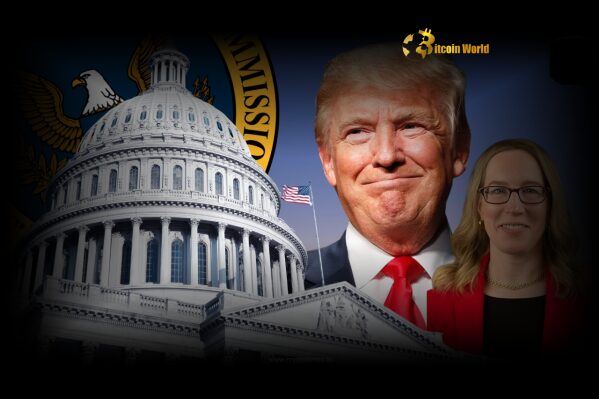BitcoinWorld

Urgent Bitcoin Market Outlook: 5 Key Factors Shaping Price This Week
Hey crypto enthusiasts! The Bitcoin market is always a whirlwind of activity, and this week is shaping up to be particularly pivotal. With global economic shifts and unique on-chain signals emerging, understanding the forces at play is crucial for anyone watching the Bitcoin market outlook. Let’s dive into the five key factors highlighted by experts that could dictate price action in the coming days.
How US Inflation and Fed Policy Impact the Bitcoin Market Outlook?
One of the most significant external factors influencing the broader financial landscape, including cryptocurrencies, is the state of the U.S. economy. This week, market participants are keenly awaiting crucial data points that could sway sentiment and risk appetite.
- April’s PCE Index: The Personal Consumption Expenditures (PCE) Index is the Federal Reserve’s preferred measure of inflation. A higher-than-expected reading could signal persistent inflationary pressures, potentially forcing the Fed to maintain higher interest rates for longer.
- Rising Bond Yields: In anticipation of or reaction to economic data and Fed policy, U.S. Treasury yields have been climbing. Higher yields on ‘safe’ government bonds can make riskier assets like Bitcoin less attractive by comparison, potentially leading to capital outflows.
- Fed’s Stance on Rate Cuts: Recent communications from the Federal Reserve have consistently pushed back expectations for near-term interest rate cuts. This ‘higher for longer’ narrative means the easy money environment that often benefits speculative assets is not returning anytime soon, adding pressure on markets.
What does this mean for the Bitcoin market outlook? Continued economic uncertainty and a hawkish Fed stance typically create headwinds for growth and risk assets. Traders and investors will be watching these economic indicators closely, as they can trigger volatility and shifts in market sentiment.
What Weak Momentum Signals Mean for Bitcoin Price?
Looking beyond macroeconomic factors, on-chain data and exchange metrics offer valuable insights into the internal dynamics of the Bitcoin market. One notable signal this week comes from the behavior of traders on centralized exchanges.
The taker buy/sell ratio is a metric that measures the volume of market buy orders initiated by takers compared to market sell orders initiated by takers. Takers are traders who execute orders immediately against existing orders on the order book, reflecting current market sentiment and urgency.
- A ratio above 1 suggests bullish sentiment, with more aggressive buying than selling.
- A ratio below 1 suggests bearish sentiment, with more aggressive selling than buying.
Currently, this ratio has dropped below 1. This indicates that market participants initiating trades are doing so predominantly through market sell orders. This ‘weak momentum signal’ points towards a potential short-term correction or a lack of conviction among buyers at current price levels. While not a guaranteed predictor, it’s a signal that aggressive selling pressure is outweighing aggressive buying pressure on exchanges, which can weigh on the immediate Bitcoin price action.
How Whale Trading Activity Influences Crypto Market Trends?
The actions of large holders, often referred to as ‘whales,’ can have a disproportionate impact on crypto market trends due to the sheer volume of their trades. Tracking whale activity provides clues about where significant capital is being deployed.
One specific example drawing attention is the trading activity of prominent figures like James Wynn on platforms known for high leverage, such as Hyperliquid. Reports indicate large shifts in his positions, moving between substantial leveraged long (betting on price increase) and short (betting on price decrease) positions.
- Market-Moving Bets: Whales trading with significant capital and leverage can create large buy or sell pressure, potentially triggering cascade effects like liquidations of smaller positions.
- Sentiment Indicator: While not always public, observing patterns in known whale activity can sometimes offer insights into the sentiment of large market participants. A sudden shift from long to short across multiple whales, for instance, might signal anticipated downside.
Monitoring such significant trading activity, even from a few key players, is important because their moves can sometimes precede larger market swings or exacerbate existing trends, impacting overall crypto market trends.
Understanding Funding Rates and Short Squeeze Potential in Bitcoin Analysis
In the world of perpetual futures contracts, funding rates are periodic payments exchanged between traders holding long and short positions. They are designed to keep the contract price close to the spot price.
- Positive funding rates mean longs pay shorts (indicating bullish sentiment and demand for long positions).
- Negative funding rates mean shorts pay longs (indicating bearish sentiment and demand for short positions).
- Neutral funding rates mean minimal exchange of funds.
Despite recent upward movements in Bitcoin price, funding rates have remained relatively neutral. This is somewhat counter-intuitive; typically, rising prices lead to positive funding as traders aggressively long the asset. The neutral funding suggests that while price is rising, the move isn’t fueled by overly aggressive, leveraged long positions.
Simultaneously, open interest (the total number of outstanding futures contracts) has been growing. Increasing open interest combined with neutral or slightly negative funding can be a potent mix. It means there’s a large number of leveraged positions open, but longs aren’t paying a premium to hold them. If price starts moving up decisively, these short positions can be forced to buy back Bitcoin to cover their positions, potentially triggering a ‘short squeeze’ that rapidly drives the Bitcoin price higher as shorts scramble to exit.
This dynamic is a key element of current Bitcoin analysis and presents a potential bullish catalyst if the right conditions materialize.
Volatility, Resistance, and the Path for Bitcoin Price
Price volatility, a measure of how much the price of an asset fluctuates, is currently on the rise in the Bitcoin market. Increased volatility means larger price swings are becoming more frequent, presenting both opportunities and risks for traders.
From a technical analysis perspective, Bitcoin is currently testing a significant resistance level – specifically, the high reached in January. Resistance levels are price points where selling pressure is expected to be strong, potentially halting or reversing an upward trend. Successfully breaking above a key resistance level is a bullish signal.
- Testing Resistance: The current price action involves repeated attempts to push past the January high. This level acts as a psychological and technical barrier.
- Breakout Potential: A ‘clean breakout’ involves price moving decisively above the resistance level on significant volume, followed by ‘follow-through’ (price staying above the level and continuing to move up).
- Upside Target: If a clean breakout and follow-through occur, it removes a major hurdle and can open the path for further upward movement. The mentioned potential target of $155,000 suggests that analysts see significant upside potential if this resistance is cleared, based on technical patterns or extensions.
Monitoring this technical battle at the resistance level is crucial for understanding the immediate direction of the Bitcoin price and identifying potential targets if momentum shifts strongly upwards. This is a critical point for short-term Bitcoin analysis.
Concluding Thoughts on the Bitcoin Market Outlook
This week presents a complex picture for the Bitcoin market outlook. We have external economic pressures from the U.S. and the Fed, internal market signals like weak exchange momentum and significant whale trading activity, and technical setups involving neutral funding rates, growing open interest, and a key resistance test. Each of these factors holds the potential to significantly influence the Bitcoin price and broader crypto market trends.
Navigating this environment requires vigilance and a keen understanding of how these disparate elements interact. While challenges like economic headwinds and bearish exchange signals exist, potential catalysts like a short squeeze or a decisive breakout above resistance offer significant upside potential. Staying informed about these five key factors is essential for making informed decisions in the volatile world of cryptocurrency.
To learn more about the latest Bitcoin market trends, explore our article on key developments shaping Bitcoin price action.
This post Urgent Bitcoin Market Outlook: 5 Key Factors Shaping Price This Week first appeared on BitcoinWorld and is written by Editorial Team





